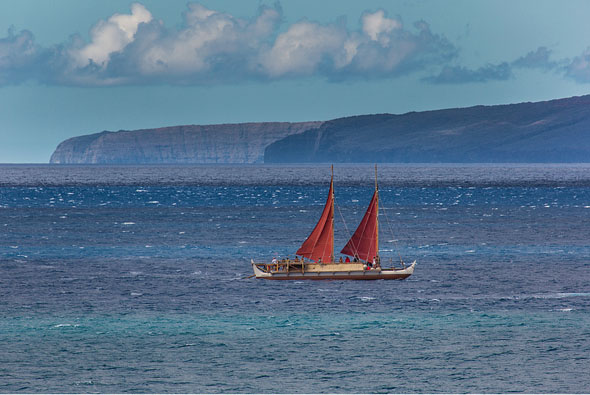HOKULEA, A TRADITION OF HAWAIIAN VOYAGING

*Photo Credit: Chris Stankis
Charting a course through Hawaii’s waters, the Hokulea — an authentic replica of an ancient Polynesian double-hulled voyaging canoe — is bringing about a renaissance of Polynesian voyaging techniques. Without any modern technology and using only Polynesian navigation techniques passed down generation through generation, the Hokulea has set her sights on revitalizing the Hawaiian and Polynesian cultures through the vehicle of seafaring.
Measuring at 61 feet and five inches and weighing in at 16,000 pounds, the Hokulea is constructed out of plywood, fiberglass and resin. The vessel, also known as waa kaulua (double hulled voyaging canoe in Hawaiian) is guided at sea by her twin masts and long paddle.
History of Hokulea
First pushing off in March 1975, the Hokulea made her famous maiden voyage from Hawaii to Tahiti in 1976. The primary goal of this first trip was to support the theory of Asiatic origin of native Oceanic people, Polynesians and Hawaiians.
As plans were made for the maiden trip, the group discovered that no Hawaiians knew the ancient techniques for open water voyaging. To teach them the art of non-instrument navigation, the Polynesian Voyaging Society recruited Satawalese Master Navigator, Maui Piailug, to share his knowledge. Led by Captain Elia David Kuualoha “Kawika” Kapahulehua and Piailug, and with the winds behind them, the first trip was launched from the sacred site of Hakipuu Kualoa, off Kaneohe Bay on Oahu.
The original Hokulea was designed by Hawaiian artist and historian Herb Kawainui Kane, one of the original founders of the Polynesian Voyaging Society, who named the Hokulea, after the star, which appeared in his dream one night. In Hawaiian, the name Hokulea refers to Arcturus, one of the guiding stars for Hawaiian navigators, which passes directly over Hawaii’s latitude, helping guide sailors to the island chain.
The Hokulea’s historic inaugural trip, was one of a series of events that led to the rejuvenation of the Hawaiian culture, including a renewed interest in native language, dance, chanting, voyaging and more, giving Native Hawaiians a sense of empowerment and pride in their people and history.
Since its 1976 passage to Tahiti, the Hokulea has completed six major trips to destinations including Aotearoa (New Zealand) and Rapa Nui.
A Society of Voyagers
Based out of Honolulu, the Polynesian Voyaging Society is a nonprofit focused on research and perpetuating traditional Polynesian voyaging methods. In 1973 a threesome of young men — including nautical anthropologist Ben Finney, Hawaiian artist Herb Kane and sailor Charles Tommy Holmes — set out to prove that ancient Polynesians had purposely settled the Polynesian Triangle without current technology or instruments. With this goal PVS (Polynesian Voyaging Society) and the Hokulea were born.
In 1978 an attempted trip to Tahiti was cancelled when the Hokulea capsized near Lanai. Well-known Hawaii waterman Eddie Aikau left the crew to find help and was lost at sea. After this trip, Piailug trained Nainoa Thompson on navigational methods and in 1980 Thompson replicated the 1976 sail to Tahiti, becoming the first modern Hawaiian to master the art of Micronesian navigation.

A Journey Around the World
For the last few years the Polynesian Voyaging Society has been training to develop the skills of more than 400 crew members from 16 different countries for the Hokulea’s highly anticipated worldwide voyage which kicked off this past May. The first leg of the canoe’s planned 45,000-mile voyage launched in May 2013 with the “Malama Hawaii” sail around the state.
The crew will travel 1,000 miles and make 30 stops across the Hawaiian island chain through October 2013, working on connecting to the community through educational outreach. The first stop on the Malama Hawaii leg is a port in Hilo Bay, where the Hokulea crew will spend their time planting koa trees, making presentations on voyaging and other outreach to the Hawaii Island community.
There are 22 planned legs for the Hokulea’s worldwide expedition, which over four years, will take Hokulea and her escort boat and sister canoe, Hikianalia to 28 countries with stops at 85 international ports. During the trip as many as 14 crewmembers will work on the Hokulea at any given time with up to 16 crew members on the Hikianalia. Without the use of fossil fuels, both ships will rely on a consistent wind and sun to power their sails and photovoltaics (which run their lights, communication tools and the Hikianalia’s engines).
Throughout the worldwide voyage no crewmember will stay on the Hokulea for more than 30 consecutive days. The crew consists of individuals from different walks of life and backgrounds including navigators, students, educators, scientists, medics, cultural leaders and even some of the Polynesian Voyaging Society’s earliest members, now 60 years of age or older.
Led by the Hokulea’s captain, navigator Nainoa Thompson, the worldwide journey is the largest and longest since her maiden trip to Tahiti in 1976. Organizers believe the trip will cost over $30 million the four-year voyage.
The mission of the Hokulea Worldwide Voyage is to help the Hokulea — a symbol of cultural pride for many of Polynesian and Hawaiian descent — make waves around the world while bringing back knowledge and cultures they experience in other countries. The trip is dubbed “Malama Honua” or “Care for the Earth” and hopes to “chart a new course toward sustainability,” helping to raise awareness for the state of our oceans and natural environment, particularly for future generations.
